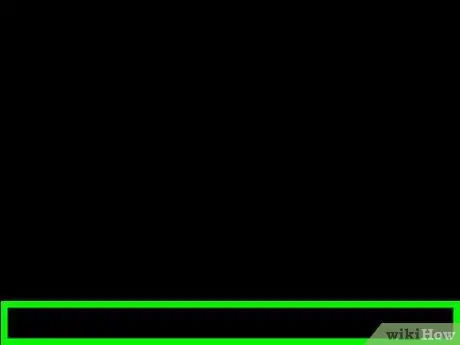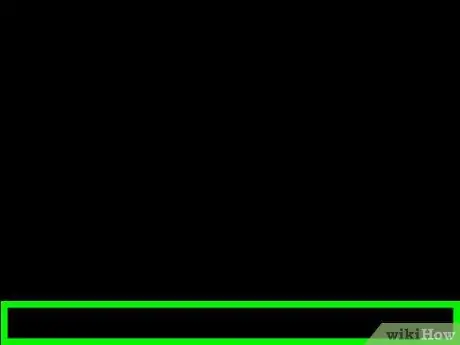- Author Jason Gerald [email protected].
- Public 2024-01-19 22:11.
- Last modified 2025-01-23 12:04.
To get more space on the screen and display the desktop background without distractions, you can hide the Windows taskbar when not in use. Hide the taskbar via the Settings menu in Windows 10, or the Taskbar Properties window in older versions of Windows. If your taskbar is still stubborn and still showing on the screen, don't worry! Just try some of the steps below.
Step
Method 1 of 4: Windows 10

Step 1. Right-click on the taskbar, then select "Settings"
Make sure you right-click an empty space on the taskbar, not on a specific icon. If you're using a touchscreen, press and hold the taskbar for a few moments, then release your finger to display the context menu.
- To open the taskbar settings menu, you can also click or tap Start, go to "Settings > Personalization", then select "Taskbar" in the menu on the left of the window.
- If you see the "Properties" option in the context menu instead of "Settings", you are using an older version of Windows 10. To hide the taskbar in older versions of Windows 10, follow the guide at the bottom of this article.

Step 2. Select the option "Automatically hide the taskbar in desktop mode" to hide the taskbar in desktop mode
If you are not using a tablet, you only need to change this setting.

Step 3. If you are using a tablet, also select the option "Automatically hide the taskbar in tablet mode" to hide the taskbar in tablet mode
You can switch to tablet mode by tapping the notification button in the lower right corner of the screen. In the notification view, tap the "tablet mode" button.

Step 4. Hover over the bottom of the screen to display the taskbar
When you hover over the taskbar, the taskbar will appear, and will be hidden again when the cursor moves away.
If you are using a tablet, display the taskbar by swiping up from the bottom of the screen,

Step 5. Change taskbar location from "Taskbar location on screen" option
Sometimes, you may feel that the taskbar is more suitable to be displayed on the left, right, or top of the screen. After selecting a new location, the taskbar will immediately move.
Method 2 of 4: Windows 8, 7, and Vista

Step 1. Right-click on the taskbar, then select "Properties"
If you are using Windows 8, select "Desktop" from the Start menu, or press Win+D first to open the desktop view.

Step 2. On the "Taskbar" tab, check the "Auto-hide the taskbar" option

Step 3. Click "Apply"
Your taskbar will be hidden. You can click "OK" to close the menu, or adjust other settings as needed.

Step 4. Hover over the bottom of the screen to display the taskbar
When you hover over the taskbar, the taskbar will appear, and will be hidden again when the cursor moves away.
Method 3 of 4: Troubleshooting

Step 1. Check the program that keeps the taskbar showing
If certain programs flash, your taskbar won't be able to "down". Switch to the program by clicking on it to stop the program from flashing.

Step 2. Check the icon on your system bar
The system bar is in the lower-right corner of the screen, right next to the clock. Like programs on the taskbar, icons on the system bar can also prevent the taskbar from "dropping down" when the icon displays notifications. Click the icon that displays the notification to see what the program needs.
The icon of the program that gives notifications may be hidden. To display it, click the arrow to the left of the icon view

Step 3. Disable notifications for specific programs
If you're getting annoyed with notifications from certain programs, or if they can't be removed and the taskbar keeps popping up, try turning off all notifications.
- Windows 10 - Click the Start menu, then select "Settings". In the Settings window, select "System > Notifications & actions". Turn off notifications for a specific program by selecting the program name in the list, or turn off all notifications from the top of the list.
- Windows 8, 7, and Vista - Click the Expand arrow next to the system bar icon, then click "Customize". Find the app you want to turn off notifications for, then select "Hide icon and notifications".

Step 4. Try reapplying the taskbar settings
Sometimes, reapplying the settings can fix the taskbar not being able to "go down". Open a Settings (Windows 10) or Properties window and turn off the option to automatically hide the taskbar. After that, click Apply (Windows 8 and below). After disabling the option, re-enable the same option, and apply the changes.

Step 5. Restart Windows Explorer
Windows Explorer is the main interface of Windows. Restarting Windows Explorer might fix the taskbar problem.
- Hold down Ctrl+⇧ Shift, then right-click your taskbar.
- Select "Exit Explorer" from the menu. The entire taskbar view, folders, and icons will disappear.
- Press Ctrl+⇧ Shift+Esc to open Task Manager.
- Click "File" > "Run new task".
- Enter "explorer", then press Enter to reload Windows Explorer.
Method 4 of 4: Troubleshooting Windows 10

Step 1. Press Win+R, then enter "powershell" to open PowerShell
If you're using Windows 10 and your taskbar keeps showing up, try using PowerShell to work around this.

Step 2. Right-click the PowerShell icon on the taskbar, then click Run as Administrator
After that, confirm your action. A PowerShell window with Administrator privileges will appear on the screen.

Step 3. Copy and paste the following command in a PowerShell window with Administrator privileges:
Get-AppXPackage -AllUsers | Foreach {Add-AppxPackage -DisableDevelopmentMode -Register "$($_. InstallLocation)\AppXManifest.xml"}

Step 4. Run the above command, and ignore the error that appears if any

Step 5. Once the command is complete, click or tap the Start menu
Now the taskbar will be hidden, according to your settings.






